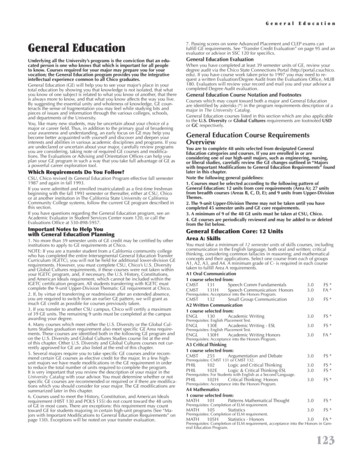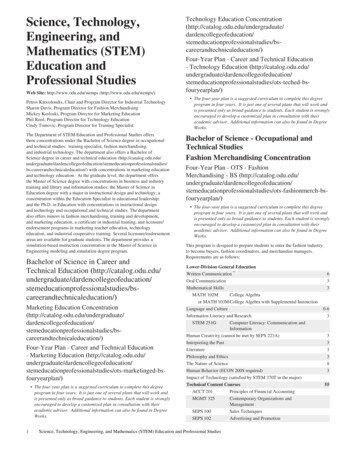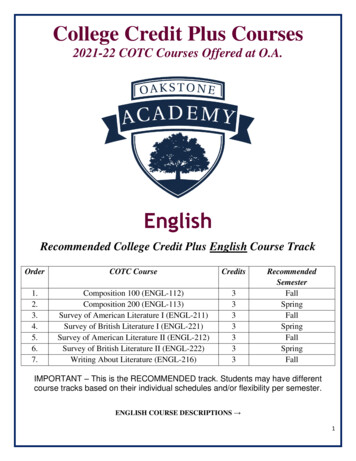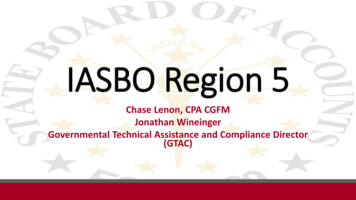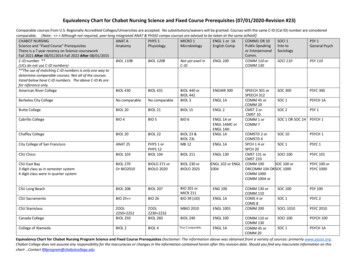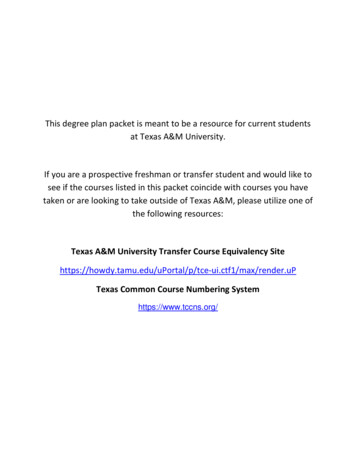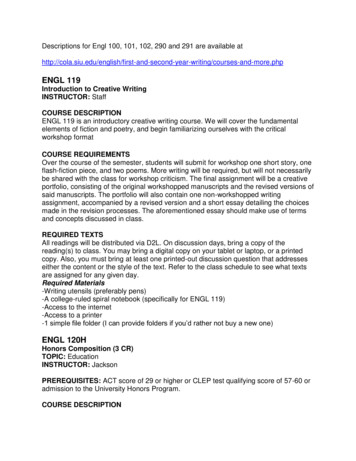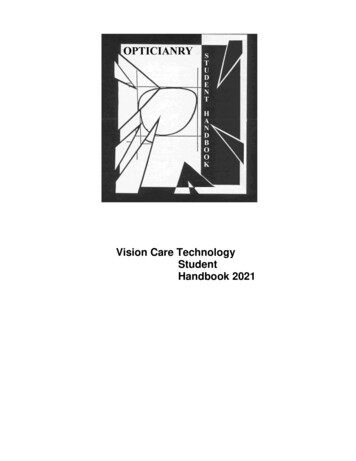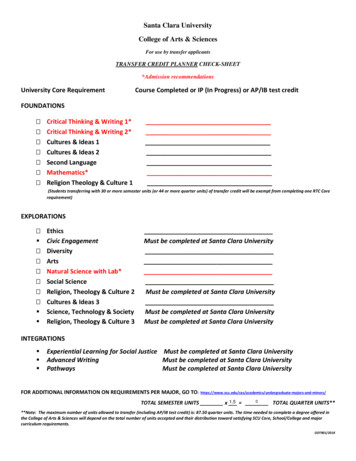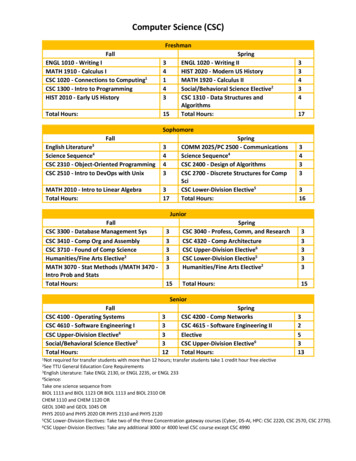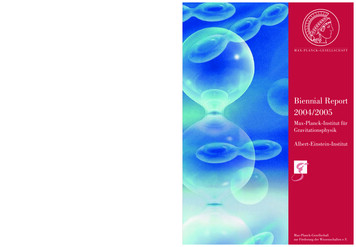
Transcription
Report
Report by the Managing DirectorThis report surveys the activities of the Max Planck Institute for Gravitational Physics (Albert Einstein Institute, AEI) in the years 2004 and2005. The 10th anniversary of our institute last year and the coinciding100th anniversary of Einstein’s annus mirabilis has focused attentionof both the scientific community and the general public onto the research areas of the institute: From the geometrical and analytical aspects of General Relativity, String Theory and other unified theories tothe astrophysics of gravitational waves and to the laser interferometryand quantum optics used to detect them, Einstein’s heritage is presentin much of the current research of the institute.The two years covered by this report have seen scientific advancesin all sections of the institute that are detailed in the reports of theindividual sections. They have also brought a further strengtheningof the international role and recognition of the institute: We are verypleased that several recipients of prizes from the Alexander von Humboldt Foundation chose the AEI as host institution for their research. Ialso mention the conference on “Geometry and Physics after 100 yearsof Einstein’s Relativity” in Golm in April 2005 where a distinguishedgroup of speakers covered all aspects of gravitation in front of an international audience of leading researchers and younger scientists, seethe detailed report in this volume.Several specific new developments have taken shape. The International Max Planck Research School in “Geometric Analysis, Gravitationand String Theory” has already attracted many new graduate studentsfrom around the world to the AEI and the participating university research groups. A second International Max Planck Research School in“Gravitational Wave Astronomy” in cooperation with Hannover University started at Hannover and Potsdam-Golm in January 2006. A new“Special Research Center” (SFB) of the German Research Foundation(DFG) in mathematics and theoretical physics with the title “SpaceTime-Matter” started in 2005 jointly between the AEI, Potsdam University, Free University and Humboldt University, strengthening thelinks between the AEI and nearby universities further and wideningthe course and seminar offerings to our PhD students. Additional research projects in string theory were launched within the newly established EU-networks “Superstrings” and “Forces Universe”, whichcame out on top among more than 600 other applications.In 2004 Yanbei Chen won the Kovalevskaja-Prize of the Humboldtfoundation enabling him to establish his research group on “Theoretical Gravitational Wave Physics” in the Astrophysical Relativity divisionof the AEI. This research will complement other efforts towards thedetection of gravitational waves such as the analysis of data from thedetectors GEO600 in Hannover and LIGO in the USA on the Merlincluster. A regular new lecture series by prominent researchers on recent astrophysical developments was also started in this division. TheAEI continues its close partnership with both the LIGO gravitationalwave detector in the US and the planned space based project of ESANASA called LISA: Following joint data-taking runs of GEO600 andLIGO in the current report period the AEI has assumed importanttasks concerning both the data analysis and the construction of Advanced LIGO. The AEI is closely involved in the mission formulationphase of the LISA Pathfinder mission that was entered in 2005, with aplanned launch in late 2008. The division in Hannover is co-PI for theexperimental aspects of this mission.
The institute was able to make several senior level appointments during the last two years: Lars Brink (Stockholm), Robert Bartnik (Melbourne) and Kenneth Strain (Glasgow) have joined the institute as external scientific members. The AEI is very pleased to have secured theregular scientific collaboration of these distinguished colleagues whichwill greatly benefit the scientific work of the institute. With the helpof additional funds provided by the Leibniz program of the GermanResearch Foundation it was possible to make a temporary senior appointment in the division “Geometric Analysis and Gravitation”: LarsAndersson from the University of Miami has joined the division forfour years as a visiting professor and will provide additional expertiseon analytical and geometrical aspects of Einstein’s equations.The institute cooperates nationally and internationally with many other research institutions and individual scientists through a number ofactivities: Longterm institutionalized cooperation agreements, honorary professorships at neighbouring universities, joint special researchcenters, graduate schools and networks with other scientists as wellas, very importantly, small research projects between individual scientists. Conferences, workshops and a regular visitor program providefurther opportunities for young scientists to forge links with the scientific community.Some members of the AEI have accepted offers elsewhere while newmembers have been attracted to the AEI: Curt Cutler has moved toa more senior position at the California Institute of Technology in autumn 2005 and in the same year Jan Plefka received a Lichtenbergprofessorship established by the Volkswagen Foundation at HumboldtUniversity. Thomas Thiemann has returned to the division “QuantumGravity and Unified Theories” of the AEI in 2004.Following the move of Ed Seidel to a senior position at LSU in BatonRouge the institute is very pleased to have attracted Luciano Rezzolla from Trieste to head the numerical relativity group in the divisionAstrophysical Relativity which is currently located in offices in Potsdam-Babelsberg. The Peyote computing cluster provides an excellentcomputing environment for this group and will be upgraded in 2006following the successful application to the computing committee ofthe Max Planck Society.The physical buildup of the institute has reached an important stagewith the completion of the new laboratories and offices in Hannoverand the fast progress on the extension building in Golm. It is expectedthat this extension building will be completed within the next monthsso that all Potsdam based research groups of the AEI will be reunitedin Golm by autumn 2006, compare the detailed report in this volume(see page 96). The move into the extension building in Potsdam willrequire an extra effort by both scientists and service sections of theinstitute.The institute gratefully acknowledges the continued support for the buildup of the AEI by the Max Planck Society. Apart from the building investments it has also secured the basic funding for the future operation andupgrading of GEO600. Outside funding of the institute has been boostedby the start of several new research programs funded by a great varietyof national and international sources: The German Research Foundation(projects in three Special Research Centers, Leibniz-Program), the EU(four separate projects), ESA/NASA (funding for LISA) and “DeutschesZentrum für Luft- und Raumfahrt” (DLR) with funding for the LISAPathfinder (for a detailed report on cooperations see page 99).
Challenges for the immediate future include the start of the seconddivision in the Teilinstitut Hannover where we hope to successfullycomplete the appointment of the fifth director of the AEI. This wouldallow the new section to become operational in the second half of2006. The new research group could then focus on data analysis andthe observation of gravitational waves, complementing the existing experimental research.The institute was visited and thoroughly evaluated concerning thequality and effectiveness of its scientific work by its “Fachbeirat” inSeptember 2005. The report of the Fachbeirat to the Max Planck Society was very positive and supportive of the research strategies of theAEI and offered very helpful advice for its future development. TheKuratorium of the AEI met in September 2005 in a historical buildingin the center of Berlin and offered additional advice to the institutehow to communicate its research to a broad public audience, see thedetailed reporting this volume. The meeting also took advantage of thecentral Einstein Year exhibition in Berlin concerning the science andlife of Albert Einstein where several exhibits of the AEI were present.The Einstein Year 2005 provided a unique opportunity for the instituteto involve the general public and in particular the young generationin its research. Elke Müller and Peter Aufmuth were supported byMarkus Pössel to plan and coordinate the many activities of the AEIthis year as described in a separate article. I particularly like to mentionhere the new website Einstein-Online with its multi-level introductioninto relativity which will remain an important point of contact for thegeneral community. The institute continues to provide a multitude oflectures for the general public, teacher and student educational lectures, open day talks and popular science lectures at the Urania inBerlin. The institute is particularly grateful to Jürgen Ehlers for hiscontinuing enthusiasm in publicly representing the institute on manysuch occasions.Nearing the end of my term as managing director I would like to thankall the scientists and all the support staff of the AEI for their continued support and enthusiasm: The building projects and the EinsteinYear have provided challenges and extra workloads. I was lucky to havefound so much help and support in all sections of the institute – thelibrary, IT-section, scientific coordination/public relations as much asin the secretariat and the administration. It will be exciting to workin such an excellent research environment in a reunited and fully extended AEI during 2006.Gerhard Huisken
Report by the Managing DirectorThe InstituteMax Planck Institute for Gravitational Physics (Albert Einstein Institute)Einstein, the Photoelectric Effect and the Nobel Prize712Research OverviewGeometric Analysis and Gravitation Division15Astrophysical Relativity Division22Quantum Gravity and Unified Theories26Laser Interferometry and Gravitational Wave Astronomy36Research HighlightsGeometric Analysis and Gravitation DivisionGeometric Aspects of Mass and Momentum45The Newtonian Limit48Astrophysical Relativity DivisionThe Gravitational Wave Group51Highlights from the Numerical Relativity Group57Applied e-Science Research61Theory of Advanced Gravitational Wave Detectors63Quantum Gravity and Unified Theories DivisionBrownian Motion, QCD and Topological Strings66Gravity Tools for Meson Physics69Laser Interferometry and Gravitational Wave Astronomy DivisionSpace Borne Gravitational Wave Detection: LISA and LISA Pathfinder72All-Reflective Interferometry with Nano-Structured Optics74IT and Library HighlightsActivities and Highlights of the IT Department in 2004 and 200577Activities and Highlights of the Library in 2004 and 200579
The Einstein Year 2005Einstein‘s Legacy and the Public81Open Day at the Research Campus Golm84EventsConference “Geometry and Physics 100 Years After Einstein’s Relativity”and 10th Anniversary Celebration, April 4-8, 2005, in Golm85Loops ‘05 at the AEI85Through the Eyes of a Visitor87News Items89Living Reviews in Relativity97Cooperations and Outside Funding99AchievementsAppraisals and Prizes103Academic Achievements:Doctoral Theses, Diploma Theses, Bachelor Theses104Lists AEIThe Fachbeirat110The Board of Trustees111Directors112Senior Scientists112Junior Scientists112PhD Students113Diploma Students113Support Staff113Guest Scientists in Potsdam-Golm 2004114Guest Scientists in Potsdam-Golm 2005118Guest Scientists in Hannover 2004 - 2005122Publications by the Institute; by AEI Members and Guest Scientists122
Lists AEI (contd.)Ligo Scientific Collaboration Author Lists143Institute Colloquium 2005 at AEI Potsdam-Golm145Invited Conference Talks Given by AEI Members146Lectures and Lecture Series Given by AEI Members153Popular Talks Given by AEI Members157Guided Tours at GEO 600160About the Max Planck Society161Contacts, How to get to the AEI in Potsdam-Golm and Hannover162Masthead164
The Institute
Max Planck Institute for Gravitational Physics(Albert Einstein Institute)The Albert Einstein Institute was founded in1995 by the Max Planck Society for the purposeof pursuing research into the fundamental lawsof gravitation. The Institute was established inBrandenburg as part of the expansion of theMax Planck Society after the reunification ofGermany. Its establishment was an initiativeof its founding Director, Jürgen Ehlers, whoretired at the end of 1998. The Institute movedfrom Potsdam City to its new building in Potsdam-Golm in 1999. In 2002 the Institute openeda branch at the University of Hannover thatspecializes in the development of gravitationalwave detectors. The GEO600 detector is operated by the Hannover branch.In 2005 the AEI celebrated ten years of existence. It was able to lookback on a decade of very rapid growth, including the founding of itsbranch institute in Hannover, devoted to experimental gravitation.During this period it has become the largest research institute devotedto gravitational physics, and it serves as a focal point for scientistsworking internationally in many areas. More than one hundred scientists visit each year; the institute regularly hosts workshops and conferences; we publish one of the principal scientific journals in relativity;and many AEI staff occupy leading positions in big collaborations, external institutions, and in public advisory bodies. Even after only tenyears, former AEI scientists occupy permanent positions and in somecases leadership positions in many of the important relativity researchgroups around the world.The AEI prospered in 2004/5. The earlier funding restrictions in theMax Planck Society eased, an extension building providing much-needed office space was begun, funds were awarded for a new cluster supercomputer, resources for opening a second division in our Hannoverbranch were approved, and the Max Planck Society also endorsed andfunded our ambitious long-range plans in gravitational wave detectionfor an upgrade of the GEO600 detector and for collaborative workwith our international partners.Science of the AEI: Relativity in Physics and AstronomyThe founding of the AEI in 1995 came at a time of enormous expansion of interest in and importance of Einstein’s theory of gravitation,general relativity. During the first 50 years after Einstein proposed histheory in 1915, mathematicians and physicists struggled to developtechniques that were capable of unravelling the mysteries of the equations and making sound physical predictions. No physical theory hadbeen as challenging mathematically as general relativity. But elegantand fundamental mathematical work in the 1960’s and 1970’s put thetheory on a sound footing: theorists understood black holes, gravitational waves, gravitational lensing, and cosmology well enough to makeconfident physical predictions.This was just in time, because general relativity was becoming important to astronomy. The application of advanced technology to astronomical observing from the ground and in space led to the discoveryof many new and exotic phenomena that could be explained only byusing relativity. Black holes, gravitational lensing, the cosmologicalconstant – it is a rare conference on astronomy today that does not dealin an almost routine way with some or all of these concepts, which twodecades ago were regarded as exotic, if not impossible.In recent years the most striking technological advances have been inthe design and construction of gravitational wave detectors of enormous size, based on the technique of laser interferometry. A worldwidenetwork of such instruments is entering full-time observing, includingthe AEI’s own 600 m detector, GEO600, a collaboration with Britishand other European scientists. These experiments could soon directlyobserve signals from distant astronomical sources that are carried bythe gravitational field itself.While astronomers were discovering how exotic our universe can be,physicists studying fundamental physics began turning to general7
relativity as well. By the mid-1970’s they had achieved considerablesuccess in understanding, at least in outline, how all the forces of nature except gravitation fit together into a single theory. They were thenready to try to include gravitation into the unified picture that wasemerging. Virtual black holes, black hole entropy, the cosmologicalconstant, inflation, wormholes, strings, eleven dimensions – fundamental physicists today work in the exciting border areas between classical gravitation and quantum field theory, searching for the “theory ofeverything”.Mathematical work in general relativity continues to flower. The theory still presents significant challenges that affect the way it is usedin astronomy and particularly in quantum gravity. The field is ever interested in new developments in any field of mathematics that canaid understanding. And, as so often happens in physics, the theory isstimulating the creation of new mathematical concepts and constructsthat themselves become interesting research topics.Structure and Research of the InstituteThe AEI brings all these threads of research together into a single institute, where scientists working in all these areas can interact with oneanother, learn from one another, and collaborate with one another. TheInstitute in 2004/5 had four divisions: three for theoretical researchin Potsdam-Golm, and the first of two planned experimental physicsdivisions in Hannover.The Astrophysical Relativity Division (Golm/Schutz) specializes in theapplications of relativity in astronomy. It has two main groups, oneconcerned with the search for gravitational radiation and the otherwith the computer simulation of black holes and their dynamics. Thegravitational radiation group analyzes data from the GEO600 gravitational wave detector and its international partners and performstheoretical studies to understand sources of gravitational waves. Thenumerical relativity group is one of the largest in the world, developingtechniques for studying situations that may be important sources ofgravitational waves but that are not amenable to analytic calculationor approximation: collisions and mergers of black holes and neutronstars.The Geometric Analysis and Gravitation Division (Golm/Huisken) extends the techniques that have unlocked the basic meaning of thetheory. The division is a leader in understanding the local and globalproperties of solutions to Einstein’s equations, both those that are dynamical and emit gravitational waves, and those that develop singularities, places where the predictive power of general relativity itselfbreaks down. The division is broadening its research into areas of geometrical mathematics that have proved powerful in studying generalrelativity in the past and which show great promise for further progressand for applications in numerical relativity and quantum gravity.The Quantum Gravity Division (Golm/Nicolai) studies methods fordeveloping a theory of gravitation that replaces general relativity bymaking it compatible with quantum mechanics, and if possible unifying gravity with the other forces of nature at the same time. There aretwo main threads to research in this area around the world, calledstring theory and canonical quantization, and the AEI is one of the fewplaces in the world where scientists study both. It is in this researcharea that the most fundamental insights and the most exciting changesin our picture of how Nature is organized can be expected.8
The Laser Interferometry and Gravitational Wave Astronomy Division(Hannover/Danzmann) develops and operates the GEO600 gravitational wave detector, in cooperation with its UK partners in Glasgowand Cardiff. The GEO collaboration is a world leader in detectortechnology. The optical and mechanical systems they designed forGEO600 are planned to be a key component in the upgrade of LIGOthat will take place at the end of this decade. The Division also plays aleading role in the development of the LISA space-based gravitationalwave detector, which is planned to be launched in 2015 jointly bythe European Space Agency (ESA) and the US space agency NASA.Danzmann is the European Project Scientist for LISA. In preparationfor LISA, the Division has a major role in the LISA Pathfinder mission,which will be launched by ESA in 2009 to test the measurement andcontrol systems designed for LISA.To support this work the AEI provides in Golm an extensive library andone of the best computing environments available to any research institute of its size. The library is a leader in providing electronic accessto journals for our scientists. Our computer installation includes notonly high-performance workstations and servers, but two teraflop-classcluster computers dedicated to specific research areas.Even more than the physical facilities, the Institute sees the work ofits support staff as a key part of its performance: caring for the needsof visitors, maintaining the computer systems and making them accessible to all, ensuring that the library responds to the needs of scientists,supporting scientists who need to administer external research grants– all of these must happen if the research environment is to be productive. Our public outreach and public relations activities are also givena high priority, because there is an especially strong interest among thegeneral public in research associated with Einstein’s theories.The Institute also maintains an extensive guest scientist program. Thelists in this report of guest scientists for 2004/5 and of seminars givenat the AEI show how rich the intellectual environment is.The AEI and UniversitiesAs the largest research institute of its kind in the world, the AEI occupies a key position not only in world research in relativity but especially in Germany. Despite the fact that general relativity was createdin Germany, research in mathematical and astrophysical general relativity is unfortunately not strongly supported at most German universities. Apart from the contributions of a strong group at the Max PlanckInstitute for Physics and Astrophysics (which became the core of theAEI when it was established) and of a few individuals and small groupsat German universities, the focus of the development of classical relativity in the 1960‘s through the 1990‘s was outside Germany. Today,increasing numbers of German students are going abroad to study thesubject at an advanced level.In order to help to make Germany attractive to young students, theAEI participates in at least four different cooperative initiatives. Thefirst is its long-standing annual vacation course in relativity, offered incooperation with the University of Potsdam, in which the AEI providesstudents from all over Germany the opportunity to learn the foundations of general relativity here. Those who want to pursue the subjectfurther may then be able to work at the AEI. The Institute, throughits partnerships with Potsdam University, the Humboldt University ofBerlin, and the University of Hannover, can supervise work towardsadvanced degrees of those universities.9
A second form of cooperation with universities is the participation ofthe AEI in two SFBs (Sonderforschungsbereich special researcharea), in which it collaborates with scientists at German universitiesin areas of mutual interest. These research grants, which run for manyyears and can involve hundreds of scientists, are a principal sourceof support for university research. One SFB joins the AEI with theUniversities of Jena, Hannover, and Tübingen and the Max PlanckInstitute for Astrophysics in Garching in a wide-ranging research program in gravitational wave astronomy, which will help to develop auniversity research community supporting the experimental activitiesof GEO600. In 2005 a new SFB in mathematics and theoretical physics entitled “Space-Time-Matter” started. This SFB is a joint projectbetween the AEI, Potsdam University, Free University and HumboldtUniversity.The AEI’s third and fourth initiatives are its two International MaxPlanck International Research Schools (IMPRS). The first one, started in 2004, is in Geometric Analysis, Gravitation, and String Theory.It is a cooperation with Potsdam University and the Free University ofBerlin. The second, which started in 2006, is in Gravitational WaveAstronomy, and is a cooperation with Hannover University. Theseschools not only offer new opportunities to German students to studyat the frontiers of physics, but they also bring good students to Germany from many countries. IMPRS’s are a very successful recent innovation by the Max Planck Society. They offer instruction throughthe medium of English and provide students with a “graduate-school”environment in which to study for a Ph.D., something which had beenlacking at German universities before.The AEI naturally also trains many young German and foreign postdoctoral scientists in its research groups. Our recent experience is thatwhen these young scientists leave the AEI they generally go to excellent academic positions, mostly outside Germany. In time, and despitethe current serious financial pressures on the German research andeducation systems, we hope that a larger fraction of our young scientists will enter academic positions at German universities, so that theycan offer many more German students the opportunity to learn aboutand work in the rapidly developing field of research in gravitation.Another resource that the AEI provides for the university community,both within Germany and outside it, is the internet-based review journal Living Reviews in Relativity. This has become a standard referencenot only for relativists but for researchers in allied subjects. The quality of the editorial board and of the reviewers has led to very high usagefigures on our website, and all of our articles have been downloadedhundreds (in some cases thousands) of times. The editorial staff ofthe journal are now supported by the Heinz-Nixdorf Center for Information Management (ZIM) of the Max Planck Society, and in recentyears we have started up two sisters journals, Living Reviews in SolarPhysics and Living Reviews in European Governance. Further journals are expected to join the family in the next year or two.The Research Vision of the AEIIn a longer view of our research, there are goals and challenges thatmotivate AEI scientists. We work from day to day, writing papers, holding meetings and other discussions, thinking in quiet isolation, travelling to work with collaborators; but all of this activity accumulates tomove research in certain directions and to prepare for certain expecteddevelopments. Here is a partial list.10
The first direct detection of gravitational waves will place the AEI atthe center of this new branch of astronomy. As a member of the mostsensitive network of detectors ever constructed, the GEO600 instrument should participate in these first detections. The data analysisgroup, our gravitational-wave theorists, and the numerical simulationsgroup will also play key roles in the interpretation of the first observations.Very soon, supercomputers will be large enough to do realistic calculations in general relativity, to perform long simulations of black holesand neutron stars merging, possibly to perform realistic calculations ofthe formation of neutron stars and black holes, and probably to exploremathematical questions, such as the development of singularities, thathave not been solved analytically so far. This work will aid in the discovery and interpretation of gravitational waves and should also raisenew questions in mathematical relativity, offering new opportunitiesfor research there.The launch of new space-based astronomical observatories – not onlyLISA but also new observatories for the cosmic microwave backgroundradiation, for X-ray astronomy, for cosmological observations in the infrared, and more – and the commissioning of many new sophisticatedground-based telescopes – 8-meter-class optical telescopes, opticalinterferometers, and survey instruments – will not only challenge uswith unexpected discoveries about black holes, their relation to theformation of galaxies, and the overall structure of the universe, butthey will provide us with a massive amount of quantitative informationabout the universe that will be unprecedented in its precision and detail. Gravitational theory will be much in demand for the interpretationof this data.Mathematics is advancing rapidly in many areas, especially in thosethat use computers as an aid to proving theorems, exploring geometrical concepts, and gaining insight into complex situations. Relativityprovides an attractive area for the application and even the development of new techniques, offering challenging problems in singularitiesand in the global structure of solutions. The cross-fertilisation of relativity and other branches of mathematics can lead to fruitful researchin the next decade.If the optimism of scientists working today in string theory and inloop quantum gravity is justified, then in only a few years we may seethe emergence of a coherent but mathematically complex theory thatshows how gravity is related to all the other forces of nature. Alreadyexciting and radical ideas are emerging about how these theories mightalter our notions of gravity, explain the Big Bang, and predict completely new phenomena. Work to understand the theories and explorepredictions that will be testable by experiments and by astronomicalobservations will require new mathematics and creative young minds.For the first time it may be possible to ask sensible questions – andexpect sensible answers – to questions like: what happens inside blackholes, what happened “before” the Big Bang, what is space-time likeon t
Doctoral Theses, Diploma Theses, Bachelor Theses 104 Lists AEI The Fachbeirat 110 The Board of Trustees 111 Directors 112 Senior Scientists 112 Junior Scientists 112 PhD Students 113 Diploma Students 113 Support Staff 113 Guest Scientists in Potsdam-Golm 2004 114 Guest Scientists in Potsdam-Golm 2005 118
